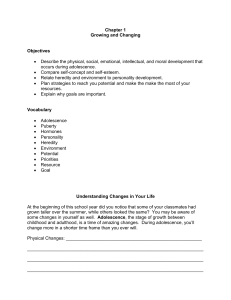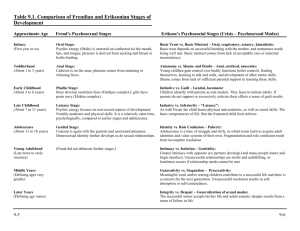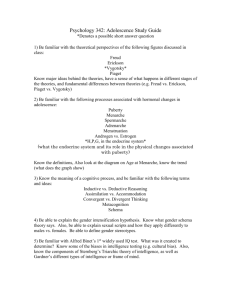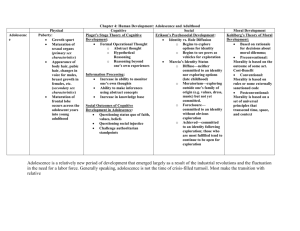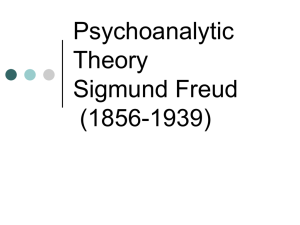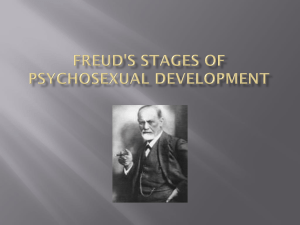AP Psychology Stage Theorists Prevailing Issues
advertisement
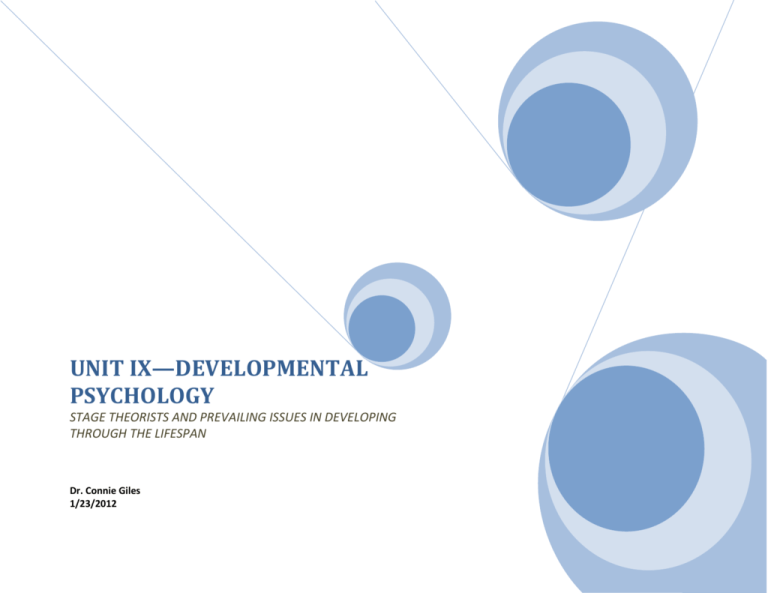
UNIT IX—DEVELOPMENTAL PSYCHOLOGY STAGE THEORISTS AND PREVAILING ISSUES IN DEVELOPING THROUGH THE LIFESPAN Dr. Connie Giles 1/23/2012 KOHLBERG’S STAGES OF MORAGL DEVELOPMENT COMPARED TO PIAGET’S STAGES OF COGNITIVE DEVELOPMENT KOHLBERG’S STAGES OF MORAL DEVELOPMENT Stages of Psychosexual Development According to Sigmund Freud, personality develops through a series of stages in which the the energies of the id are focused on certain erogenous areas. This psychosexual energy, or libido, was described as the driving force behind behavior. Stage Age Characteristics Oral Stage Birth to 1 year An infant's primary interaction with the world is through the mouth. The mouth is vital for eating, and the infant derives pleasure from oral stimulation through gratifying activities such as tasting and sucking. If this need is not met, the child may develop an oral fixation later in life, examples of which include thumb-sucking, smoking, fingernail biting and overeating. Anal Stage 1 to 3 years Freud believed that the primary focus of the libido was on controlling bladder and bowel movements. Toilet training is a primary issue with children and parents. Too much pressure can result in an excessive need for order or cleanliness later in life, while too little pressure from parents can lead to messy or destructive behavior later in life. Phallic Stage 3 to 6 years Freud suggested that the primary focus of the id's energy is on the genitals. According to Freud, boy's experience an Oedipal Complex and girl's experience and Electra Complex, or an attraction to the opposite sex parent. To cope with this conflict, children adopt the values and characteristics of the same-sex parent, thus forming the superego. Latent Stage 6 to 11 years During this stage, the superego continues to develop while the id's energies are suppressed. Children develop social skills, values and relationships with peers and adults outside of the family. Genital Stage 11 to 18 years The onset of puberty causes the libido to become active once again. During this stage, people develop a strong interest in the opposite. If development has been successful to this point, the individual will continue to develop into a wellbalanced person. Stages of Adolescent Development Stages of Adolescence Early Adolescence Approximately 11 – 13 years of age Middle Adolescence Approximately 14 – 18 years of age Physical Development Cognitive Development Puberty: grow body hair, increase perspiration and oil production in hair and skin, Girls – breast and hip development, onset of menstruation Boys – growth in testicles and penis, wet dreams, deepening of voice Tremendous physical growth: gain height and weight Greater sexual interest Growing capacity for abstract thought Mostly interested in present with limited thought to the future Intellectual interests expand and become more important Deeper moral thinking Puberty is completed Physical growth slows for girls, continues for boys Continued growth of capacity for abstract thought Greater capacity for setting goals Interest in moral reasoning Thinking about the meaning of life Social-Emotional Development Struggle with sense of identity Feel awkward about one’s self and one’s body; worry about being normal Realize that parents are not perfect; increased conflict with parents Increased influence of peer group Desire for independence Tendency to return to “childish” behavior, particularly when stressed Moodiness Rule- and limit-testing Greater interest in privacy Intense self-involvement, changing between high expectations and poor self-concept Continued adjustment to changing body, worries about being normal Tendency to distance selves from parents, continued drive for independence Driven to make friends and greater reliance on them, popularity can be an important Stages of Adolescence Late Adolescence Approximately 19 – 21 years of age Physical Development Young women, typically, are fully developed Young men continue to gain height, weight, muscle mass, and body hair Cognitive Development Ability to think ideas through Ability to delay gratification Examination of inner experiences Increased concern for future Continued interest in moral reasoning Social-Emotional Development issue Feelings of love and passion Firmer sense of identity Increased emotional stability Increased concern for others Increased independence and self-reliance Peer relationships remain important Development of more serious relationships Social and cultural traditions regain some of their importance THREE PREVAILING ISSUES IN PSYCHOLOGY’S EXAMINATION OF DEVELOPING THORUGH THE LIFE SPAN: Nature versus Nurture •To what extent are the qualities that we possess "inborn" or acquired via genetic inheritiance? •To what extent are the qualities acquired as a result of our experiences and enviromental influences? Continuity versus Discontinuity •How much does development simply slow and continuours, and based on experiences? •How much of our development is "discontinuous: (i.e., predisposed, biologically determined and genetically pre-set to unfold in stages)? Stability versus Change •Are peoples' personalities consistent, or do they change over time? •Researc shows there is consistency to personality, yet life is a process of becoming •Earliest years provide a poor basis for determining personality •As peole grow older, personality stabilizes
